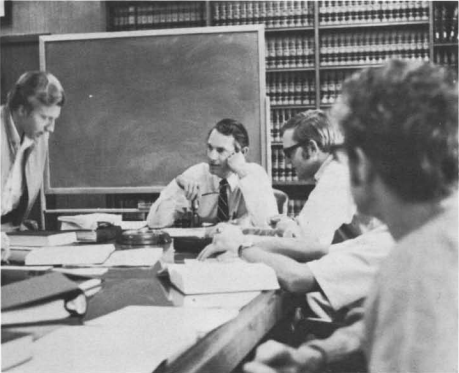Environmental Law at Stanford
Those of you who came back to Stanford for the 1970 Summer Alumni College on the Environment brought legal training to the investigation of environmental issues. One of the faculty participants was Professor William Baxter ’56, former consultant to the Federal Aviation Agency and an outspoken critic of the SST on economic grounds. Recognizing the need for leadership by the legal profession in the pursuit of a quality environment, Professor Baxter has published significant legal studies on environmental pollution and is currently working on the legal aspects involved in the distribution of international resources.
Others on the Law faculty are expanding this area of the curriculum, adding to the list of established courses such as land-use controls and water law. Professor Robert Girard, an avid conservationist, teaches Environmental Issues, an examination of selected problems relating to the nature and quality of the physical environment with emphasis on governmental organization, powers and planning for purposes of environmental control. Professor Charles Meyers, consultant to the National Water Commission, is developing materials for an experimental course in Environmental Law to be offered this spring. The course will consider the legal aspects of environmental protection, including procedure and remedies as well as substantive concepts.
Professors Girard and Meyers have acted as advisers to the student-run Environmental Law Society (ELS) since it was organized in the fall of 1969 to offer student volunteer legal assistance to conservation organizations, citizens’ groups, public agencies and lawyers.
While many traditional law student organizations are courtroom-oriented, ELS members most often find themselves exploring other areas of the legal process in their efforts to combat air and water pollution, profligate land and resource use and the final despoiling of wildlife and wilderness. They must interpret legislation, deal with municipal officials and understand the powers and politics of administrative agencies.
About 25 students are active in ELS, working on projects such as these: a study of county planning commissions for the California Joint Legislative Committee on Open Space; an investigation of federal and state alternatives to the Army Corps of Engineers’ proposed Pescadero Creek dam; an attempt to prevent irreparable damage to streamfish which will be caused by a proposed temporary sewage treatment plant; a proposal for litigation aimed at removing the lead from gasoline; legal research on a San Mateo county logging suit; a study of methods to control haphazard recreation homesite development in a rural county; a panel discussion on land-use trends in the Bay Area with representatives from planning, law, conservation, private development and the state legislature.
Last summer, ELS members conducted two highly successful studies of local land-use problems. One project, funded by John D. Rockefeller III, centered on the misuse of land in San Jose. Nine law students and three students from other disciplines studied San Jose’s rapid two-decade change from an agricultural area to an urban center under the proclaimed goal of making the city the “Los Angeles of the North.” After ten weeks of intensive field research and writing, the students recommended a restructuring of the process for making decisions on how land will be used in San Jose. As a result, the San Jose City Council has created an Environmental Task Force to consider how large the city should be and other policy questions.

The second land-use project is an attempt to save the coastal region directly to the west of Stanford from irresponsible urban development. Four students researched water supply, waste treatment, zoning administration and taxing policy and have continued to work with concerned citizens to preserve the area’s natural resources.
Some projects are tied into writing courses, giving the student a real problem to deal with instead of a hypothetical one. While researching water rights in the upper Klamath River basin for a class in water law, ELS President David Jackman found contracts being negotiated by the United States Bureau of Reclamation which would have seriously threatened sound water management on two important federal wildlife refuges in northern California. He circulated a summary of his findings and a petition for recommended action to conservation leaders and governmental officials and later discussed the problem in detail with the Assistant Secretary of the Interior for Fish, Wildlife and Parks. These efforts brought together a broad coalition of conservation groups in opposition to the contracts and effectively stopped contract negotiations while the Interior Department undertakes a full review of their advisability. Mr. Jackman has found that students are not always heard, but when they are, they are considered objective.
James Rummonds, one of the students who helped organize ELS, has been named by President Nixon to the National Commission on Population and the American Future. The Commission, headed by John D. Rockefeller III, is conducting a two-year study of the long-term effects of unchecked population growth on the American environment.
Mr. Rummonds is also the founder and coordinator of the National Environmental Law Society (NELS), formed at Stanford in late 1969 as a clearinghouse for information on the local efforts of environmental law societies around the country. NELS attempts to coordinate the work of societies at more than 40 law schools and develop the communication necessary to avoid duplication of effort. The NELS newsletter serves as an open forum for students, professors and attorneys engaged in environmental work to contribute ideas and report on topics being researched, involvement in litigation and activities with local bar groups.
Now a privately financed, unincorporated association, NELS is seeking tax-exempt and nonprofit research organization status. As an independent, national organization, NELS hopes to involve all segments of the legal community in the search for solutions to environmental problems.
